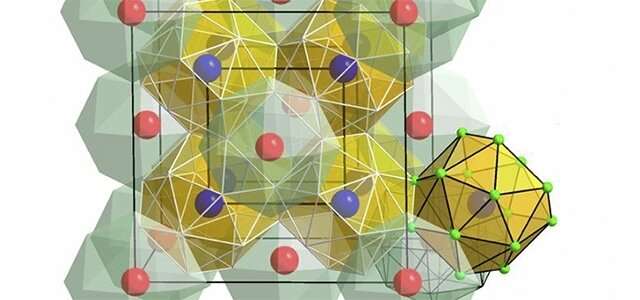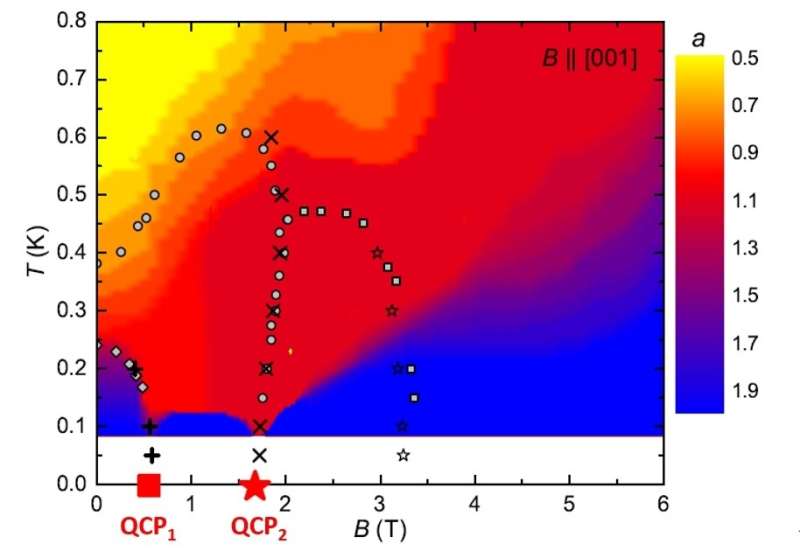Quantum transition makes electrons behave as if they lack spin

The common phase transitions are those that occur as a function of temperature variation. Ice changes phase to become liquid water at 0 degrees Celsius. Liquid water changes phase to become water vapor at 100 degrees Celsius. Similarly, magnetic materials become nonmagnetic at critical temperatures. However, there are also phase transitions that do not depend on temperature. They occur in the vicinity of absolute zero [-273.15 degrees Celsius] and are associated with quantum fluctuations.
A study involving experiments under extreme conditions, especially ultra-low temperatures and intense magnetic fields, and accompanied by theoretical interpretation of the experimental results explored this type of situation and investigated the quantum critical point manifested in a highly unusual transition.
Italian researcher Valentina Martelli and Peruvian Julio Larrea, both professors at the University of São Paulo Physics Institute (IF-USP) in Brazil, participated in the study, which is published in Proceedings of The National Academy of Sciences (PNAS).
The experimental part, led by Professor Silke Paschen, was conducted in the laboratories of the Vienna University of Technology (TUW) in Austria. The theoretical work was performed by a group led by Qimiao Si, Professor of Physics and Astronomy at Rice University in the United States.
"We found and interpreted evidence of two successive quantum critical points associated with a double breakdown of the Kondo effect," Larrea told.
Named for Japanese physicist Jun Kondo (born 1930), the Kondo effect explains the formation of heavy fermions in metal compounds based on rare-earth elements. In these compounds, the electrons behave collectively owing to their strong correlation, forming a singlet (a collective of distinct particles that behave as a single particle), which can be represented as the coupling of the localized magnetic moment of the rare-earth ion with the conduction electron around it. This quasi-particle can reach masses up to thousands of times the mass of a free electron.
In the study described here, the singlet was broken twice in two magnetic orders: one dipolar, resulting from the magnetic moment of the quasi-particle, and the other quadrupolar, resulting from the interaction between its electronic orbitals.
The experiment was performed with the heavy fermion Ce3Pd20Si6, a compound of cerium (Ce), palladium (Pd) and silicon (Si). Larrea is set to continue the investigations with support from São Paulo Research Foundation via the project "An investigation into topological and exotic quantum states under extreme conditions."

"The starting point for these transitions is the strong correlations between electrons and certain materials, which enable us to understand this type of state change," Larrea said.
"Various kinds of collective interaction can affect electrons. One possible state is what we call 'strange metal." In heavy fermions, electron transport is analogous to that of ordinary metals, but the electrons are strongly correlated and behave collectively as if they formed a single quasi-particle, which transports the charge. This is not what happens in a quantum phase transition, so the state is called 'strange." What we observed experimentally is that physical properties such as electrical resistance behave quite differently from classical electron transport in metals."
The phenomenon occurs at extremely low temperatures very close to absolute zero. When temperatures fall this low, thermodynamic fluctuations practically disappear, and quantum fluctuations are observed, constituting the "medium" in which interactions among electrons take place.
"Until the publication of our study, most experiments of this kind had focused on materials in which electron correlation leads to what is known as simultaneously itinerant and localized electron magnetism. These materials belong to the group of rare earths and include heavy fermions: 'fermions' because the electrons have fractionary spin and obey Fermi-Dirac statistics; 'heavy' because they correlate with a quasi-particle with large effective mass," Larrea said.
"These materials also have a magnetic moment, so in addition to a charge-carrying quasi-particle, they are also associated with a quasi-particle with a magnetic moment shielded or screened by the conduction electrons. Each screened magnetic moment can be coupled to its neighbor in the crystal lattice, producing a magnetic order throughout the material. In the case of Ce3Pd20Si6, this order is of the anti-ferromagnetic kind, which means that the magnetic moments in the lattice are coupled in an anti-parallel fashion. At the quantum critical point, this magnetic order can be suppressed without the influence of a thermodynamic control parameter but by applying a magnetic field. The Kondo singlet breaks down, and the electron that was coupled to this magnetic order simply separates."
This does not contradict the fundamentals of quantum mechanics, but it is very different from what is described in basic physics textbooks. Because the magnetic moment is defined relative to the spin, the suppression of the magnetic order creates a situation in which the electrons appear to lack spin.
"This quantum critical point based on a magnetic order had previously been reported in other articles," Larrea said. "The difference in our case was that besides the dipolar magnetic order, the material also exhibited a quadrupolar magnetic order generated by the electrons' orbitals. Our phase diagram, which is almost a graphical summary of the study, therefore shows two quantum critical points: one in which the dipolar order is disrupted, and the other in which the quadrupolar order is broken."
According to Larrea, apart from this discovery, the results of the study are also important insofar as they contribute to an understanding of other unsolved problems, such as how electrons are collectively organized to produce superconductivity. "A collective order is needed to produce long-range transport," he said. "Certain kinds of material with strong correlations among electrons can provide this. We now know that these strong correlations can be suppressed to favor the formation of new states with measurable physical properties, even at temperatures different from absolute zero."
The next step is to extend the investigation of changes in electron correlations using a different control parameter—pressure—so that it will be possible in the future to make technological use of this knowledge in areas such as quantum computing.
More information: Valentina Martelli et al, Sequential localization of a complex electron fluid, Proceedings of the National Academy of Sciences (2019). DOI: 10.1073/pnas.1908101116
Journal information: Proceedings of the National Academy of Sciences
Provided by FAPESP




















